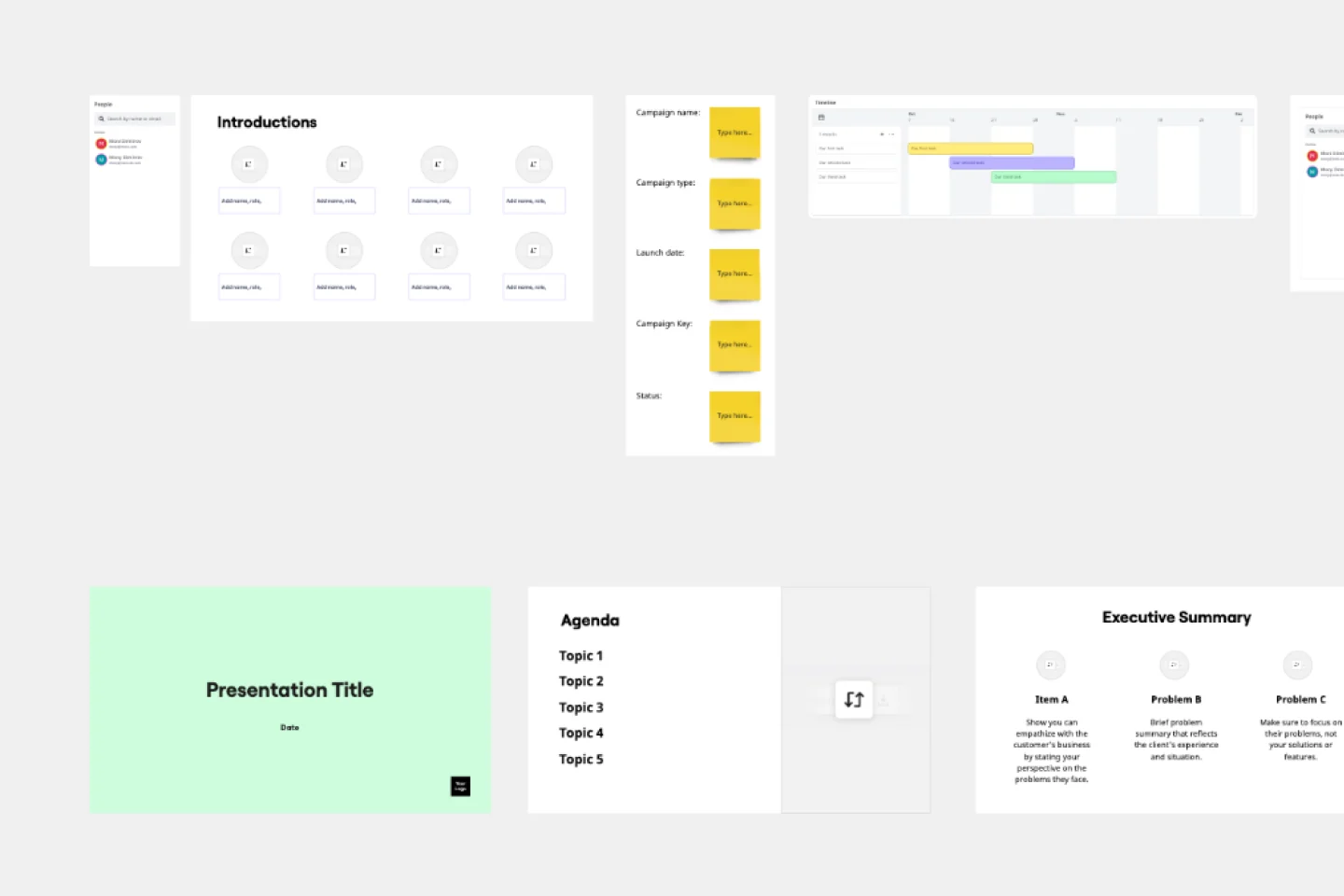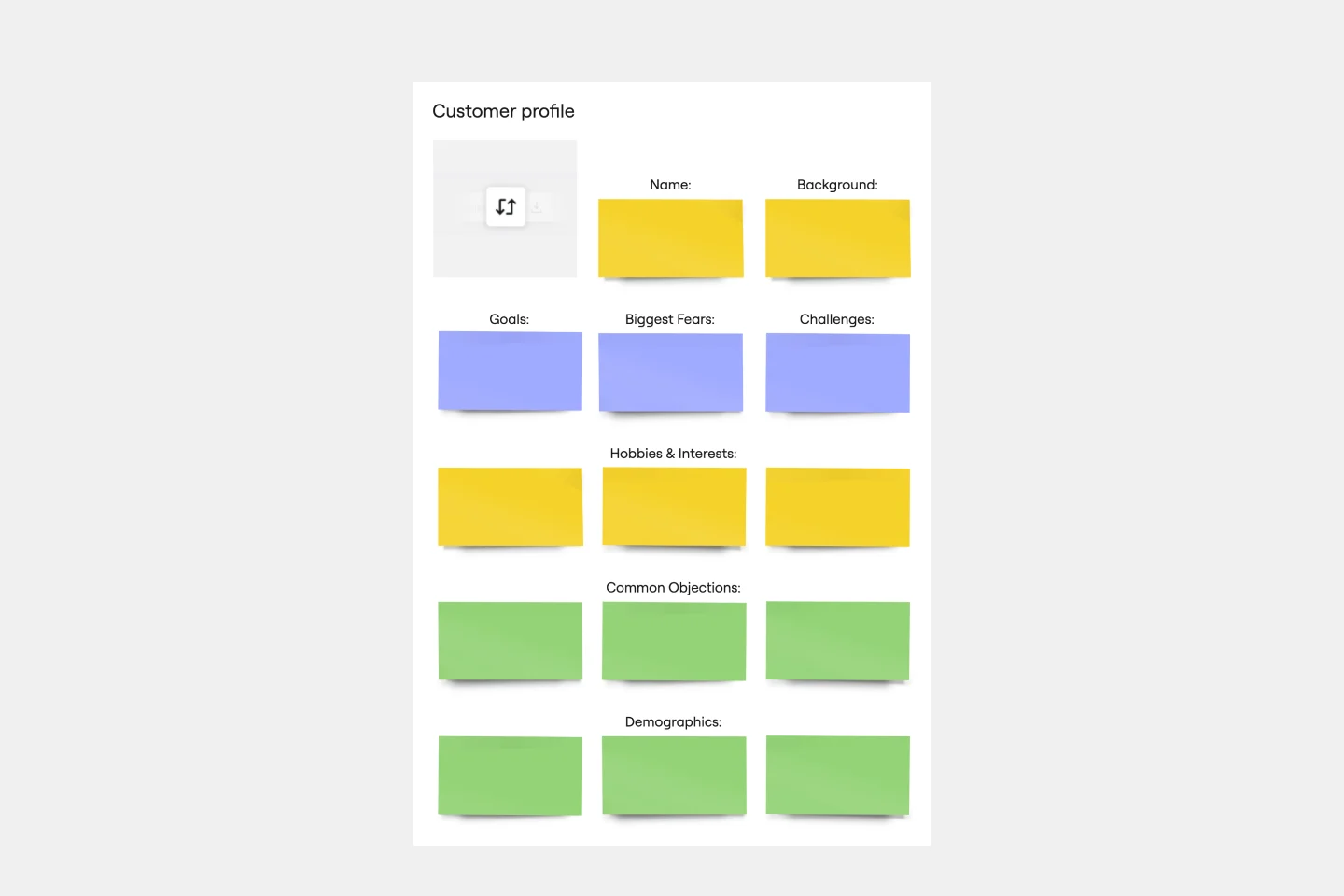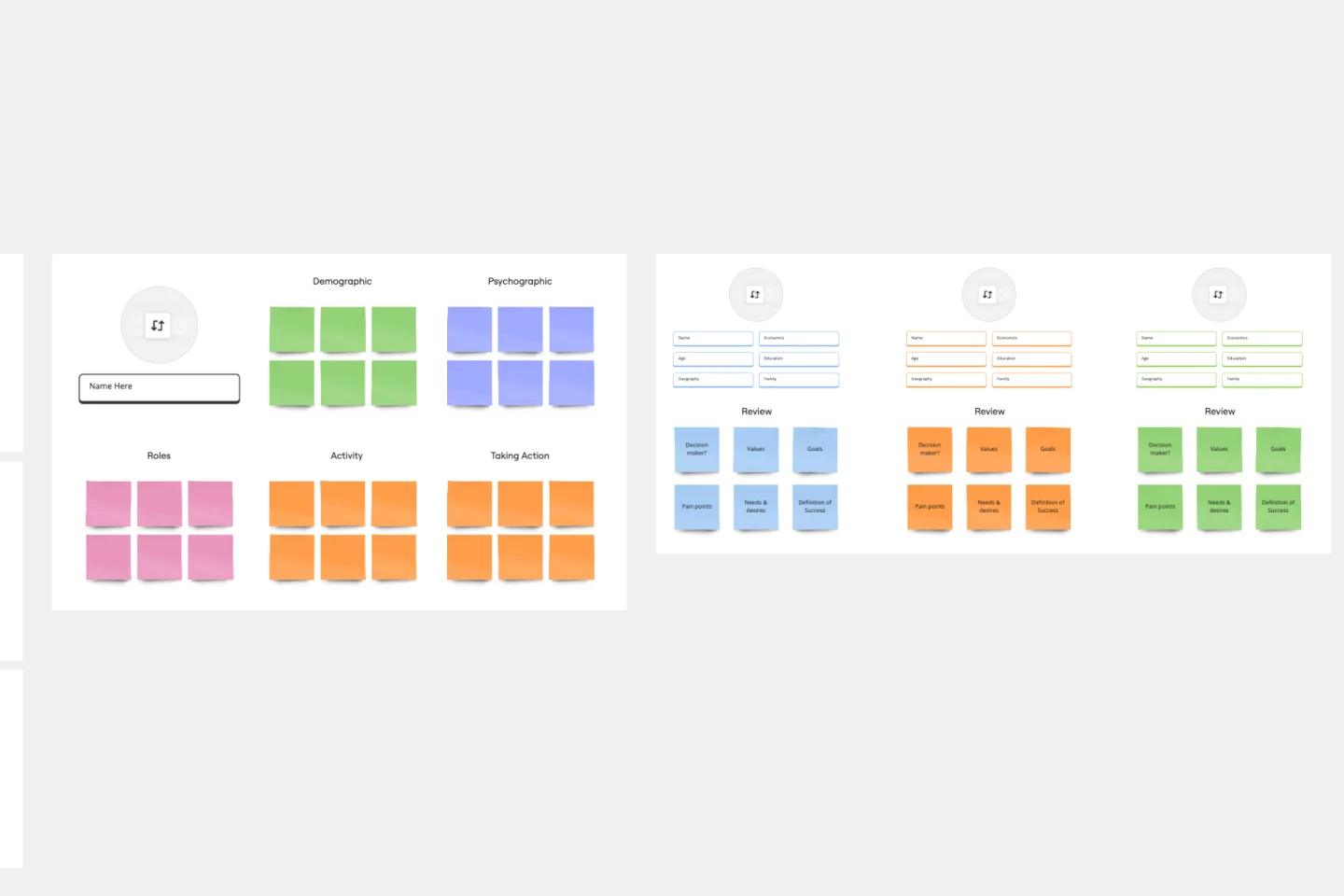About the REAN template
The REAN Template is a four-factor framework for mapping and analyzing various marketing activities. It helps marketing teams visualize solutions and set goals for the future.
The template is split into four quadrants — Reach, Engagement, Activation, and Nurture. Marketing teams can use these quadrants to review past projects, identify areas of improvement, and discover new opportunities for growth.
What is the REAN model?
The REAN model measures the efficacy of marketing efforts. It was first introduced by Xavier Blanc in 2006 and popularized by Steve Jackson in Cult of Analytics. Today, marketing teams use it for a variety of reasons. In fact, many teams rely on the REAN model because of its flexibility.
The REAN model can be adapted to a variety of marketing efforts, such as planning measurement frameworks, deciding on marketing objectives, mapping digital marketing channels, and creating new digital strategies.Marketing teams can also use it to develop KPIs to capture how well their marketing campaigns are working.
The four factors of the REAN model
To use the REAN model effectively, you need to understand its four main quadrants:
1. Reach measures your ability to raise awareness of your brand and attract relevant traffic to your site. For example, you might use paid ads or marketing automation to reach a wider audience.You can measure reach by tracking your impressions divided by frequency.
2. Engagement helps you understand how customers interact with your brand. Measurements include the number of clicks, your conversion rate, the average session duration, and more. A high interaction engagement rate is a good indication that your marketing activity is working.
3. Activation measures customer actions on your website. Many teams choose to measure activation through conversion metrics — for example, how many customers click the call to action. This process gives you a better understanding of the customer journey, helps you build a better relationship with your customers, and boosts customer satisfaction.
4. Nurture captures whether visitors return to your site and consume more of your content. The aim is to create a loyal audience that keeps coming back for more. Remarketing plays a big role in this process, as it targets customers who have already visited your site or bought from you in the past. You can measure nurture by tracking how previous customers engaged with your business.
How to create a REAN model using Miro’s template
Miro’s digital workspace is the perfect canvas on which to create a REAN framework. Our ready-made REAN Template is collaborative, easy to use, and customizable. Follow these steps to create the perfect REAN framework for your business:
Step 1: Select this template. Start by choosing Miro’s REAN Template. It’s free to use and intuitive, so you don’t have to spend hours training to learn how to use it. Simply sign up and jump straight in.
Step 2: Add the relevant information to the quadrants. When you’re in the template, you’ll see the four quadrants of the REAN framework. Add your key information into these quadrants so you can start your analysis.
Step 3: Share the template with your team. With all the information in the template, you can now share it with your team and any external stakeholders. They can review the template before you move on to the next step.
Step 4: Collaborate and make changes. After sharing the template, you can work with your team to discuss the information and provide feedback. This process will make sure that you’ve covered everything and that you’re heading in the right direction.
Step 5: Create a plan of action. From here, you can create an action plan for your future goals. This plan will be based on the information you’ve reviewed from past marketing activity.
How to run a REAN workshop
To host a REAN workshop, you need to understand how the process works. To give you an idea of how to prepare, here’s an overview:
Determine the actors
An actor is anyone who makes decisions about your marketing activity or performs marketing tasks. For example, financial actors are in control of budgets and spending. Business actors are the decision-makers who create business strategies. You need to know who all of these people are so that you determine who to involve in the workshop and whose approval you’ll need to make changes.
Create the REAN diagram
Use Miro’s template to bring your diagram to life and easily collaborate with your team. You can also split the quadrants of the template into slides if you want to deliver the framework as a presentation.
Discuss the quadrants
The workshop should be a collaborative process in which everyone involved discusses the different elements of the REAN framework. To encourage collaboration, take a look at some of our brainstorming templates.
Create an action plan
After reviewing the REAN framework, continue the collaboration process and use Miro's action plan templates to create a plan of action. This plan should outline what you’ve learned from the workshop and how you’ll apply this information to your future marketing activity.
REAN Template FAQs
What does REAN stand for?
REAN stands for: Reach, Engage, Activate, and Nurture. These cover each of the main stages a marketer’s audience goes through on their journey to becoming a customer.
What’s the difference between the REAN model and the RACE framework?
RACE is a four-step marketing framework for mapping and managing engagement activities. It stands for Reach, Act, Convert, and Engage, and it was created by SMART Insights. RACE and REAN both map and manage engagement activities, but the RACE planning framework focuses more on desired actions.

Miro
The AI Innovation Workspace
Miro brings teams and AI together to plan, co-create, and build the next big thing, faster. Miro empowers 100M+ users to flow from early discovery through final delivery on a shared, AI-first canvas. By embedding AI where teamwork happens, Miro breaks down silos, improves alignment, and accelerates innovation. With the canvas as the prompt, Miro’s AI capabilities keep teams in the flow of work, scale shifts in ways of working, and, ultimately, drive organization-wide transformation
Categories
Similar templates
Marketing Campaign Template

Marketing Campaign Template
The Marketing Campaign Template is designed for effortless team collaboration. By providing a centralized space for planning, the template fosters a collaborative environment where ideas converge seamlessly. This enhances communication and cultivates a collective effort toward campaign success, allowing teams to share insights, refine strategies, and drive campaigns to new heights. With this template, collaboration becomes the cornerstone of campaign excellence, ensuring optimal results through your team's collective intelligence.
Digital Marketing Plan Template

Digital Marketing Plan Template
Crafting an effective digital marketing strategy can be a daunting task, but the Digital Marketing Plan Template can make it easier for you. This tool allows you to map out every channel tactic and is particularly beneficial in fostering collaboration among team members in a centralized space. The template's clear structure and intuitive editing features ensure a well-defined digital marketing strategy while also encouraging real-time collaboration. With the ability to seamlessly collaborate, share insights, and collectively contribute, your team can create a dynamic and successful digital marketing plan.
Audience Persona Template

Audience Persona Template
The Audience Persona Template is an essential tool that helps gain valuable insights into the target demographic. It ensures that every strategic decision is tailored to meet the specific needs and preferences of the audience. The template is designed to cover areas like Background, Hobbies and Interests, Goals, Biggest Fears, Challenges, Common Objections, and Demographics. This detailed approach enables the creation of a nuanced and multi-dimensional audience profile. By understanding the basic demographic information and the target audience's deeper motivations, challenges, and apprehensions, teams can develop more empathetic, effective, and targeted strategies. This depth of understanding leads to more resonant and successful product developments, marketing campaigns, and customer engagement initiatives.
Go-to-Market GTM Template | Miro

Go-to-Market GTM Template | Miro
It doesn’t matter how innovative or effective a new product is — if it doesn’t get noticed and adopted by the right audience, the product won’t get off the ground. That’s where your Go-to-Market Strategy comes in. It’s a single resource that houses all of your research, insights, and data, and includes your business plan, target audience, marketing approach, and sales strategy. A GTM is especially important for any startups who grow fast, have to make split-second decisions, and have to be fully in sync.
Target Audience Template

Target Audience Template
Understanding your target audience is vital to business success. How can you market yourself effectively if you don’t know who you’re targeting? Using the Target Audience template, you can review valuable data about who your customers are and what they want from your product or service.
Marketing Campaign Template

Marketing Campaign Template
The Marketing Campaign Template is designed for effortless team collaboration. By providing a centralized space for planning, the template fosters a collaborative environment where ideas converge seamlessly. This enhances communication and cultivates a collective effort toward campaign success, allowing teams to share insights, refine strategies, and drive campaigns to new heights. With this template, collaboration becomes the cornerstone of campaign excellence, ensuring optimal results through your team's collective intelligence.
Digital Marketing Plan Template

Digital Marketing Plan Template
Crafting an effective digital marketing strategy can be a daunting task, but the Digital Marketing Plan Template can make it easier for you. This tool allows you to map out every channel tactic and is particularly beneficial in fostering collaboration among team members in a centralized space. The template's clear structure and intuitive editing features ensure a well-defined digital marketing strategy while also encouraging real-time collaboration. With the ability to seamlessly collaborate, share insights, and collectively contribute, your team can create a dynamic and successful digital marketing plan.
Audience Persona Template

Audience Persona Template
The Audience Persona Template is an essential tool that helps gain valuable insights into the target demographic. It ensures that every strategic decision is tailored to meet the specific needs and preferences of the audience. The template is designed to cover areas like Background, Hobbies and Interests, Goals, Biggest Fears, Challenges, Common Objections, and Demographics. This detailed approach enables the creation of a nuanced and multi-dimensional audience profile. By understanding the basic demographic information and the target audience's deeper motivations, challenges, and apprehensions, teams can develop more empathetic, effective, and targeted strategies. This depth of understanding leads to more resonant and successful product developments, marketing campaigns, and customer engagement initiatives.
Go-to-Market GTM Template | Miro

Go-to-Market GTM Template | Miro
It doesn’t matter how innovative or effective a new product is — if it doesn’t get noticed and adopted by the right audience, the product won’t get off the ground. That’s where your Go-to-Market Strategy comes in. It’s a single resource that houses all of your research, insights, and data, and includes your business plan, target audience, marketing approach, and sales strategy. A GTM is especially important for any startups who grow fast, have to make split-second decisions, and have to be fully in sync.
Target Audience Template

Target Audience Template
Understanding your target audience is vital to business success. How can you market yourself effectively if you don’t know who you’re targeting? Using the Target Audience template, you can review valuable data about who your customers are and what they want from your product or service.